Guinea Pigs Planet
Guinea Pig Breed Guide
THE TEXEL

The Texel cavy is characterized by the ringlets or curls that make up it's long, soft coat.
Curls are to be found all over the body, even on the belly.
The Texel has a short, compact body, with a broad,well-rounded head.
The Texel was accepted as a recognized breed by the American Rabbit Breeders Association, Inc. in (1998)
This breed was originally imported from England.
BOB Texel - 2001 ARBA National Show - Del Mar, CA
Curls are to be found all over the body, even on the belly.
The Texel has a short, compact body, with a broad,well-rounded head.
The Texel was accepted as a recognized breed by the American Rabbit Breeders Association, Inc. in (1998)
This breed was originally imported from England.
BOB Texel - 2001 ARBA National Show - Del Mar, CA
THE TEDDY

The Teddy cavy is currently one of the most popular breeds in the United States.
It's short, dense, even coat is unique in having a "kinked" or bent hair shaft, which causes the coat to stand erect over
the entire body of the cavy. The coat is to demonstrate "resiliency" - that is, it should return to an even, upright appearance
immediately after it is disturbed. The Teddy should have a medium length body and a Roman nose.
Teddies and Rexes are characterized by their short-fuzzy hair and usually occur in self coloration (see below). Teddies and Rexes appear the same but their genetic make-up is different. These breeds of guinea pigs are suitable for outdoor housing and are extremely adorable. They are seasonal in the market and come at a reasonable price for such a unique breed. They require grooming once or twice a week to maintain the fuzzy outlook, and also require monthly baths as the fuzzy hair collects dirt and dust.
Availability: Uncommon , Price Range: $120.00 to $350.00
BOB Teddy and RESERVE CAVY (TS&W) - 2001 ARBA National Show - Del Mar, CA
photo credit: Pat Haefele
It's short, dense, even coat is unique in having a "kinked" or bent hair shaft, which causes the coat to stand erect over
the entire body of the cavy. The coat is to demonstrate "resiliency" - that is, it should return to an even, upright appearance
immediately after it is disturbed. The Teddy should have a medium length body and a Roman nose.
Teddies and Rexes are characterized by their short-fuzzy hair and usually occur in self coloration (see below). Teddies and Rexes appear the same but their genetic make-up is different. These breeds of guinea pigs are suitable for outdoor housing and are extremely adorable. They are seasonal in the market and come at a reasonable price for such a unique breed. They require grooming once or twice a week to maintain the fuzzy outlook, and also require monthly baths as the fuzzy hair collects dirt and dust.
Availability: Uncommon , Price Range: $120.00 to $350.00
BOB Teddy and RESERVE CAVY (TS&W) - 2001 ARBA National Show - Del Mar, CA
photo credit: Pat Haefele
TEDDY SATIN
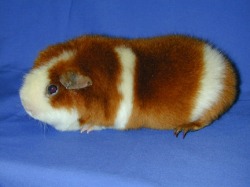
The Teddy Satin is similar in coat and appearance to the Teddy, with the additional coat quality of Satin sheen added.
The Teddy Satin is to have a dense, even, resilient coat, medium body length, and of course, exhibit good sheen.
Availability: Uncommon , Price Range: $120.00 to $350.0
BOB Teddy Satin - 2001 ARBA National Show - Del Mar, CA
The Teddy Satin is to have a dense, even, resilient coat, medium body length, and of course, exhibit good sheen.
Availability: Uncommon , Price Range: $120.00 to $350.0
BOB Teddy Satin - 2001 ARBA National Show - Del Mar, CA
THE ABYSSINIAN

The Abyssinian cavy is one of the three original breeds recognized by the American Rabbit Breeders Association, Inc.The Abyssinian coat is defined by a symmetrical pattern of rosettes and ridges.
The coat is to be crisp and harsh, so as to lend itself to clearly defined rosettes andridges.
In order to be shown, an Abyssinian must have a minimum of eight rosettes.
The Abyssinian is to be allowed to move about when being judged, so as to better exhibit it's rosettes and ridges.
Availability: Very Common , Price Range: $45.00 to $200.00
BOB Abyssinian (Roan) - 2002 ACBA Specialty Show - Hamburg, NYphoto credit: Pat Haefele
The coat is to be crisp and harsh, so as to lend itself to clearly defined rosettes andridges.
In order to be shown, an Abyssinian must have a minimum of eight rosettes.
The Abyssinian is to be allowed to move about when being judged, so as to better exhibit it's rosettes and ridges.
Availability: Very Common , Price Range: $45.00 to $200.00
BOB Abyssinian (Roan) - 2002 ACBA Specialty Show - Hamburg, NYphoto credit: Pat Haefele
ABYSSINIAN SATIN

The Abyssinian Satin cavy is a Satinized version of the Abyssinian.
Like the Abyssinian, it is required to have a set pattern of rosettes and ridges,
with a minimum of eight rosettes present to be showable.
The Abyssinian Satin is furthermore distinguished by the brilliant sheen, or "shininess" of it's coat.
Abyssinian Satins often seem to sparkle as they move across a show table
BOB Abyssinian Satin (Roan) - 1999 ARBA National Show - Louisville, KY
photo credit: unknown
Like the Abyssinian, it is required to have a set pattern of rosettes and ridges,
with a minimum of eight rosettes present to be showable.
The Abyssinian Satin is furthermore distinguished by the brilliant sheen, or "shininess" of it's coat.
Abyssinian Satins often seem to sparkle as they move across a show table
BOB Abyssinian Satin (Roan) - 1999 ARBA National Show - Louisville, KY
photo credit: unknown
ALPACA

Alpaca guinea pigs have hair like Peruvians but most strands are wavy at the end. They usually have one rosette on top of their heads. This gives its coat a woollen effect, and here lies the trouble with Alpacas as their coats are often subjected to entanglement and get dirty easily. Daily grooming is essential, and as with all long-furred guinea pigs, should have an enhanced dietary system Alpaca guinea pigs are not suitable for outdoor housing.
Availability: Rare , Price Range: $120.00 and above
Availability: Rare , Price Range: $120.00 and above
SHELTIE

Shelties are like Coronets but they do not have a rosette on top of their heads. Like Coronets, they require regular grooming to maintain their smooth coats and are unsuitable for outdoor housing. They come in a variety of colors but are not always available, since long hair is a recessive gene. Shelties are characterized further by long hair covering the body and short hair at the facial regions. They are relatively easy to care for.
Availability: Uncommon , Price Range: $120.00 to $150.00
Availability: Uncommon , Price Range: $120.00 to $150.00
THE PERUVIAN
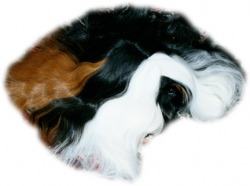
The Peruvian cavy was the first long-haired breed accepted by the American Rabbit Breeders Association, Inc.
This breed is notable for it's long, dense, soft "sweeps" of hair which can grow out to several inches in length.
The Peruvian has a "frontal" of hair, which grows forward, covering it's head, giving it an even,
circular appearance when an animal in full show coat is groomed out properly.
This is the long haired breed! The Peruvian arrived in Paris around 1886-87, and came to England shortly after. When they were first shown in America under the standards of the National Breeders and Fanciers of America, there were only three recognized breeds: The American, the Abyssinian and Angoras (long hair). In the early 1930's, Angora was changed to Peruvian and the Silkie was cast aside. The Peruvian is noted for it's long, silky hair. The side and rear sweeps should be of equal length for a balanced look. The forelock covers the face. When presented for judging on a show board the coat resembles a circle of hair. It is sometimes difficult to tell front from rear on a Peruvian. Show Peruvians need regular grooming and wrapping of the long coat to keep it from being soiled or tangled. It can be a challenge, but the results are stunning. Pet and breeder Peruvians are trimmed for easier care.
Availability: Uncommon , Price Range: $200.00 and above
BOB Peruvian and RESERVE CAVY (TS&W) - 2001 ACBA Specialty Show
photo credit: R. Spitzer
This breed is notable for it's long, dense, soft "sweeps" of hair which can grow out to several inches in length.
The Peruvian has a "frontal" of hair, which grows forward, covering it's head, giving it an even,
circular appearance when an animal in full show coat is groomed out properly.
This is the long haired breed! The Peruvian arrived in Paris around 1886-87, and came to England shortly after. When they were first shown in America under the standards of the National Breeders and Fanciers of America, there were only three recognized breeds: The American, the Abyssinian and Angoras (long hair). In the early 1930's, Angora was changed to Peruvian and the Silkie was cast aside. The Peruvian is noted for it's long, silky hair. The side and rear sweeps should be of equal length for a balanced look. The forelock covers the face. When presented for judging on a show board the coat resembles a circle of hair. It is sometimes difficult to tell front from rear on a Peruvian. Show Peruvians need regular grooming and wrapping of the long coat to keep it from being soiled or tangled. It can be a challenge, but the results are stunning. Pet and breeder Peruvians are trimmed for easier care.
Availability: Uncommon , Price Range: $200.00 and above
BOB Peruvian and RESERVE CAVY (TS&W) - 2001 ACBA Specialty Show
photo credit: R. Spitzer
PERUVIAN SATIN
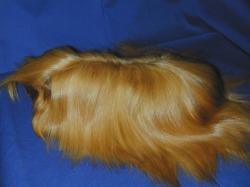
The Peruvian Satin was recognized as the 10th official breed in Jan., 1988, by the ARBA. It has all the appearance and qualities of the Peruvian with the additional
beauty of the satin sheen.
BOB Peruvian Satin (Red) - 2001 ARBA National Show - Del Mar, CA
photo credit: Pat Haefele
beauty of the satin sheen.
BOB Peruvian Satin (Red) - 2001 ARBA National Show - Del Mar, CA
photo credit: Pat Haefele
THE SILKIE
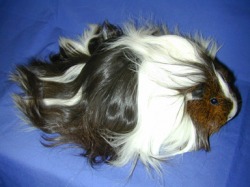
The Silkie is one of the oldest known breeds. It became a new, recognized breed in England in 1973 and is called a "Sheltie." It has been accepted and recognized as an official breed twice in America. First in 1932 and then again in 1980. It was called an Angora in 1932. The breed was officially re-recognized as the 6th breed by the ARBA in Jan., 1980. The coat of the Silkie should be soft, dense, and have no evidence of any rosettes or forelock. The hair should grow back from the face forming a mane. The mane sweeps from between the ears to flow over the shoulders and back. There should be no part in the mane. The side sweeps may be slightly shorter than the rear sweep. When viewed from above, the Silkie presents a "tear drop" shape. The coat of the show Silkie should be groomed and wrapped every other day. Pet and breeder Silkies are trimmed short for easier care. This is a particularly cuddly pig, besides the softness of the coat, the personality tends to be very mellow, making for a wonderful lap pig!
Availability: Uncommon , Price Range: $150.00 and above
BOB Silkie (Broken) - 2001 ARBA National Show - Del Mar, CA
photo credit: Pat Haefele
Availability: Uncommon , Price Range: $150.00 and above
BOB Silkie (Broken) - 2001 ARBA National Show - Del Mar, CA
photo credit: Pat Haefele
SILKIE SATIN
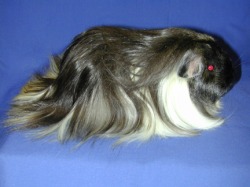
The Silkie Satin was the 9th breed recognized by the ARBA in Jan., 1987. The Silkie Satin has all the features of the Silkie with the added beauty of the satin sheen to the coat.
Availability: Uncommon , Price Range: $150.00 and above
BOB Silkie Satin (Broken) - 2001 ARBA National Show - Del Mar, CA
photo credit: Pat Haefele
Availability: Uncommon , Price Range: $150.00 and above
BOB Silkie Satin (Broken) - 2001 ARBA National Show - Del Mar, CA
photo credit: Pat Haefele
CORONET

Coronets are gorgeous guinea pigs but require extensive grooming everyday to maintain their elaborate coats. They, unlike the Shelties, have a rosette on top of their heads. Coronets are unsuitable for outdoor housing as their coats will be easily dampened and soiled. As with all long-furred guinea pigs, Coronets should be fed an enhanced diet (see DIET).
Availability: Uncommon , Price Range: $100.00 and above
Availability: Uncommon , Price Range: $100.00 and above
AMERICAN
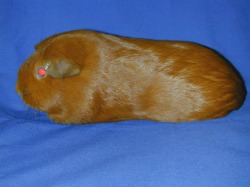
The American cavy is smooth coated, short haired, sleek and elegant.It has a medium body length, with a Roman nose, and high, full crown.It is the most popular of all the cavy breeds.The American was one of the original breeds accepted by the American Rabbit Breeders Association, Inc.At the time of it's original appearance in the Standard of Perfection, it was known as the "English" cavy.
Availability: Quite Common , Price Range: $35.00 to $100.00
BOB American (REO) - 2001 ARBA Nationals - Del Mar, CA
photo credit: Pat Haefele
Availability: Quite Common , Price Range: $35.00 to $100.00
BOB American (REO) - 2001 ARBA Nationals - Del Mar, CA
photo credit: Pat Haefele
THE WHITE CRESTED
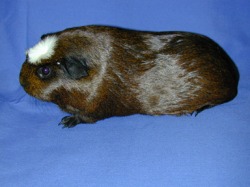
The White Crested cavy is a short haired, smooth coated cavy.It has a distinctive white crest placed on top of it's head.
There can be no other white spots anywhere on the animal, the only white is to be found in the crest.
Therefore, certain color varieties, such as Dutch, Roan, Dalmatian, and White, are not accepted colors for this breed.
The cavy pictured above was the first White Crested to ever win Best in Show at an ARBA National Convention.
Availability: Most Common , Price Range: $30.00 and above
BOB White Crested (Solid Golden)
BEST IN SHOW - 2001 ARBA National Show
Del Mar, CA photo credit: Pat Haefele
There can be no other white spots anywhere on the animal, the only white is to be found in the crest.
Therefore, certain color varieties, such as Dutch, Roan, Dalmatian, and White, are not accepted colors for this breed.
The cavy pictured above was the first White Crested to ever win Best in Show at an ARBA National Convention.
Availability: Most Common , Price Range: $30.00 and above
BOB White Crested (Solid Golden)
BEST IN SHOW - 2001 ARBA National Show
Del Mar, CA photo credit: Pat Haefele
DALMATION/ROAN

DUTCH

Dutch is a colouration characterised by a white body with eye patches and a rump of a different colour. Another example of Dutch colouration is the guinea pig used in the header of this site. Dutch coloration is a rare pattern to find in the market these days due to extensive in-breeding, cross breeding and availability.
HIMALAYAN
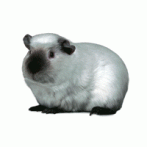
Himalayan is a distinct colour type which is characterised by a white basecoat and a paint nose, ears and feet in sooty brown or black. Himalayan coats are often accompanied with red eyes. Himalayan colouration is not a common colouration and guinea pigs with this pattern are normally important and would hence yield a higher cost. This guinea pig shown in the picture is a Himalayan English Crested.
SELF
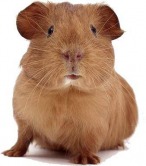
Self is a colour type characterised by a single colour spanning the entire body of the guinea pig. Self colours come in beige, black, buff, chocolate, cream, golden, lilac, red, saffron, slate, and white. Due to cross breeding and in breeding, self colour types are not often found. The term ’self’ is also used to describe extended regions of a guinea pigs coat which are of the same colour.
TORTOISESHELL
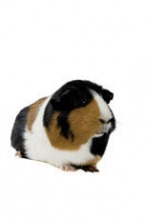
Tortoiseshell is a colour type comprising three distinct colours, often black, white and brown/red. This combination usually occurs in a set of checks covering the entire body of the guinea pig. Tortoiseshell colour types are often very rare and quite difficult to find in the market because of an increased popularity for other colour types and also due to cross-breeding.
